
Mathematical ImageryMathematical artists create strong, stunning works in all media and explore the visualization of mathematics
Fractal Art: Beauty and Mathematics
Fractal Art: Beauty and Mathematics
was an exhibit at the 2006 International Congress of Mathematicians in Madrid, Spain. The works were selected through the International Contest of Fractal Art ICM2006, which Benoit Mandelbrot, "the father of fractal geometry," chaired. (Read more about Mandelbrot.) The 25 works featured in the exhibit and in this album represent current fractal art as well as all the different techniques used in it.
"How wonderful that one object should be at the same time so easy to draw and so complex, involving as it does one of the most challenging and frustrating open conjectures in mathematics. And in addition--as shown by this beautiful Exhibit--it is sweet and friendly to every citizen's eye. How wonderful that the organizers imagined and implemented this Exhibit. Between a Congress defining the cutting edge of mathematics and all the citizens of the world, it does not erect the wall of an Ivory Tower (or Fortress) but an extraordinarily mutually beneficial bridge.
— Benoit Mandelbrot (1924-2010)
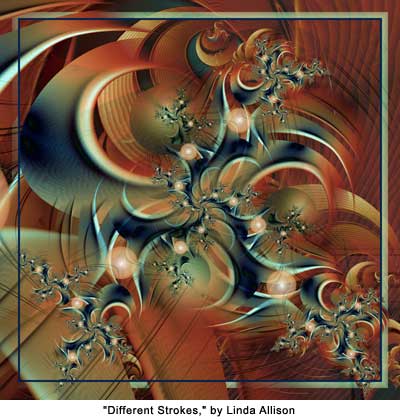
This image, like most of those selected for this exhibition, is generated with Ultra Fractal, designed by Frederik Slijkerman. "Different Strokes" consists of 10 layers, using Julia and Mandelbrot fractal formulas with other formulas and algorithms for coloring. The layers are merged into a unique image using different techniques and transparencies for each layer in the composition. The author, Linda Allison, is a disabled housewife living in Florida. Since 1994, Linda has dedicated part of her free time to designing fractal images. Having no formal mathematical training, Linda possesses an incredible ability to represent the concept of infinity in images with smooth and delicate color palettes. Her shapes blend and separate in absolute harmony, with balanced framing that combines the classicism of the first fractals with the latest advances of fractal art.

This image comes from the fusion of the three separate image files generated with the software Apophysis, designed by Mark Townsend. Each one of the files contains different types of transformations-linear, polar, and spherical-that produce a curious dialog between the vertical lines, the sinuous curves with the appearance of smoke, and the bubbling circular shapes. In this type of fractal there is only one method of coloring. Sometimes a tiny change to the color gradient can distort the image dramatically. Fractal artists, hunting for treasure, can tease out unexplored forms, but a slight difference in this or that parameter can make them pass by that secret treasure without seeing its hidden beauty. David April lives in Illinois (USA). His interest in fractals is relatively recent, but he compensates for that with an enormous enthusiasm and fascination for finding new forms.

Bill Beath is an Australian photographer specializing in depicting nature, the countryside and architecture. His photographic work combines raditional film processes with the most modern digital techniques. His first contact with fractals was a photograph of a Nautilus shell, which led to the Fibonacci sequence, which led to his discovery of fractals and fractal art. Since then, Bill Beath has been permanently immersed in fractal art, as much as an art form as an integral part of his photographic work. For that reason this image is based on the "Fibonacci Julia" algorithm, developed by Kerry Mitchell. It shows a fascinating shape somewhere between a natural design and an exquisite man-made design. The name of the image, "Ebony and Ivory," refers to the palette used, based on elegant tones of black and white.
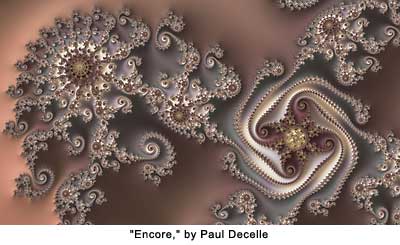
Paul DeCelle is a mechanical engineer in Michigan (USA). His image for this exhibition is a very handsome composition based on a portion of the Mandelbrot set (magnified approximately 10 to the 13th times). The artist has used techniques known for more than 10 years, but can still surprise the viewer by its majesty, especially in large-scale reproductions. If we imagine the Mandelbrot set as an extensive mountain range, the composition relies on two basic principles. The "Slope" algorithm assigns the same color to those regions with the same height, like in a topographical map. The "Lighting" algorithm colors towards white those regions of the surface illuminated by an imaginary sun sitting on the horizon, while the shadows partially obscure the surface. The result is a three-dimensional effect that enriches and enhances the detail in the original fractal.
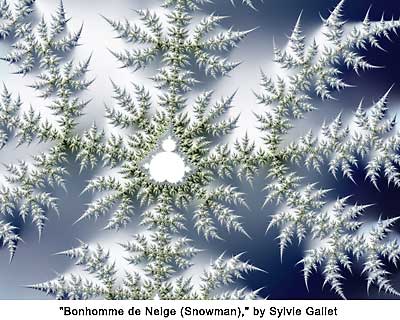
Sylvie Gallet is a mathematics professor at a secondary school near Paris. With 20 years of experience in writing fractal formulas and algorithms, she is an expert in the handling of color gradients. In fact, Sylvie avoids complex and postprocessed images, in preference to designs with little elaboration, whose value resides in the intelligent and creative use of color. "Bonhomme de Neige" is a good example of Sylvie's art. It is a conceptually simple image, but the careful use of color transports us immediately to an image of Christmas and winter countryside. Few fractal artists are capable of transmitting such direct visions and sensations.

Damien Jones is a respected artist and fractal expert. His Internet domain fractalus is one of the most complete sources to start with for fractal art. Through years of explorations of the mathematics for aesthetic reasons, Damien?s work has appeared in numerous books, magazines, posters, calendars, and international exhibitions. Born in the United Kingdom, he currently resides in Florida (USA) with his wife Michelle, whom he married while collaborating on the organization of this exhibition. The image "Overwrought" belongs to the Mandelbrot set, although it is difficult to see because of the use of "turbulence," which distorts the calculations before the application of the fractal coloring. After the image is colored, the turbulence is removed and the calculation continues. The process produces a cloudy texture but keeps the underlying shapes unaltered. The coloring?austere, mournful, and at times apocalyptic?often produces an emotional response in the viewer of the art.

Nada (Brigitte) Kringels is a German expatriate who has been living in Spain for 14 years, where she learned to use Ultra Fractal. This image consists of 25 layers using basically two algorithms designed by Kerry Mitchell, "Gaussian Integer" for the background and "Rose Range Lite" for the top layers. During the composition phase of the image, Nada Kringels discovered various shapes that immediately resembled some of the work of M.C. Escher, so she decided to introduce geometric impossibilities into the design. To finish the background, in marked feminine character according to the author, she began to imagine that it had been made by Mrs. Escher. Fascinated with this possibility, Nada Kringels began to consider in her image the idea of Mrs. Escher as an artist, without even knowing if this Mrs. Escher existed?in fact she did, Jetta Umiker, with whom Maurits Cornelius Escher had three children. Ah, by the way, how is your husband, Mrs. Escher?

Many fractal formulas and algorithms produce conventional geometric figures with certain parameters. For example, the Julia set iterated using the origin as its parameter produces a circle. The style of Klaus-Peter Kubik is focused on producing conventional geometric figures using fractal techniques. He likes to explore the combinations of the simple figures of circles and squares with attractive shapes for the viewer. He also exploits the possibilities of fractal geometry to create textures. The rough, grey texture of the circle symbolizes the surface of the moon while the vertical and horizontal lines, similar to those made with a pencil, emphasize the geometric structure of the image. Klaus-Peter Kubik works for the German government in the public health field and has participated in nearly a dozen exhibitions since 1994.

Dan Kuzmenka is a North American researcher in the field of chemistry. Like many other scientists, Dan discovered fractal geometry in 1985 reading an article in the magazine Scientific American, although it wasn't until 1999 that he began to create his first fractal images. Mateko is a word invented by its author, who maintains a personal challenge to find new ways of expressing spirals--the most important fractal icon--without showing the same shape time and time again. For this image he experimented with different color palettes and ways to combine them before the colors we now see appeared; these colors are unusual for Dan Kuzmenka, who usually uses warmer colors and earth tones.
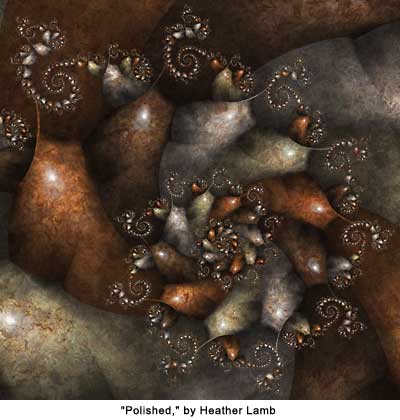
Heather Lamb was born and lives in Scotland. From an early age she has developed a strong interest for mathematics that strengthened by her studies at the Open University, where she became familiar with fractal geometry and the Mandelbrot set. A strong association exists between nature and fractal geometry and Heather Lamb exploits this, creating images that evoke the real world while at the same time transforming mathematics into something that can be understood and visualized. For this image she was inspired by her childhood experiences with polished stones, in which the true beauty of their colors is only discovered during the process of polishing. The colors were chosen to reproduce the appearance of stone, but also to be harmonious with each other and produce a balanced image. Masks with black and white gradients were used to precisely place the shadows and lights and provide a realistic sensation of polish and a tangible, three-dimensional effect that accentuates the image.
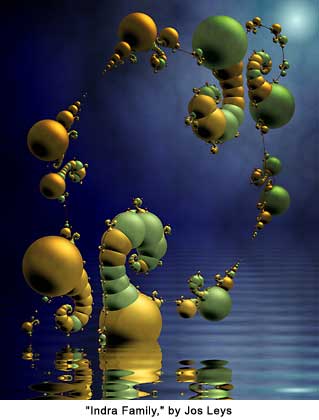
Jos Leys is a Belgian mechanical engineer who has always shown a special interest for mathematics in general and fractal art in particular since he programmed his first fractal image 25 years ago. "Indra Family" is a tribute to the professors David Mumford, Caroline Series and David Wright, the authors of the book "Indra?s Pearls: The Vision of Felix Klein." The iterative calculation techniques of the Kleinian Groups described in this book reveal new fractal images that until then had remained unexplored. The name "Indra's Pearls" is a Hindu and Buddhist concept that represents a network of silk strings that extend to infinity in all directions, and contains at each intersection a very bright and luminous pearl that reflects each of the pearls of the network, that then reflect the others and so on, without end, like mirrors reflecting to infinity.
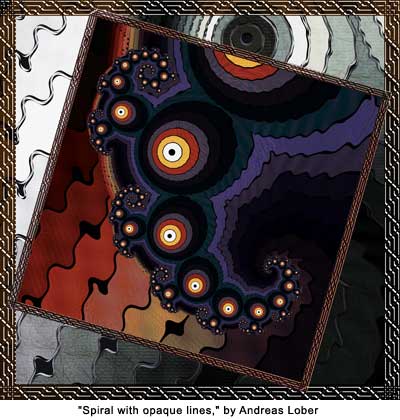
This image belongs to a simple Julia set, but the refined technique of Andreas Lober, who graduated from the University of Heidelberg with a degree in mathematics, converted it entirely into a creative prodigy. The coloring algorithm is simple: find the minimum value of $|z|$ during the iteration, deflecting lightly the values pseudo-randomly; this produces the sine waves that heighten the composition. The values are trapped during the calculation in discrete intervals; this produces the peculiar coloring that appears to be done with colored pencils. Other preferences of Andreas Lober include designing tilings that cover the plane with squares containing geometric shapes, so that they fit perfectly with the adjacent eight squares. These experiments produce tesselations of great visual impact and, in this case, variations have been used to obtain the frames contained in the image.
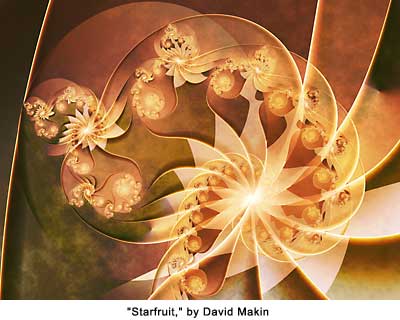
David Makin is a British computer programmer born in North Wales, who loves fractal geometry and science fiction. The majority of his work comes from his investigations into the use of coloring algorithms. In this case he employed three algorithms applied to a Julia set. The first of his algorithms, named "MMF3-Turning Points," generated the starred forms that characterize the image and suggested the title of the shape immediately to him (the starfruit is a tropical fruit whose cross section produces a five-pointed star). With the second algorithm, "MMF3-Orbital Waves," he used the idea of complementing the first layer with the handsome curved lines that accentuate the set. At this point he proceeded to include the third algorithm, "MMF3-Alternative fBm II," which provides a more organic texture. Finally, David Makin took considerable time in combining the three layers with color palettes and the algorithms described that produced the final result.
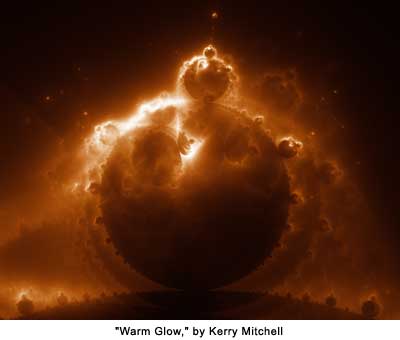
Kerry Mitchell is an aeronautical engineer born in Iowa (USA) who since 1984 has occupied diverse positions related to NASA. At the same time he is a computational artist of great technical resources that he uses to represent fractal images and visualize mathematical relationships. A subject that always accompanies the work of Kerry Mitchell is to show the complexity and beauty that flows through extremely simple mathematical rules. The metaphorical idea of the complexity of nature associated with the simplicity of deterministic mathematical formulas is a constant in his work. For this image Kerry Mitchell has applied to a zoom of the Mandelbrot set a coloring algorithm named "Buddhabrot," invented by Melinda Green (see "The Buddhabrot Technique"). The result is an image of mystical character that suggests a seated Buddha at different scales.
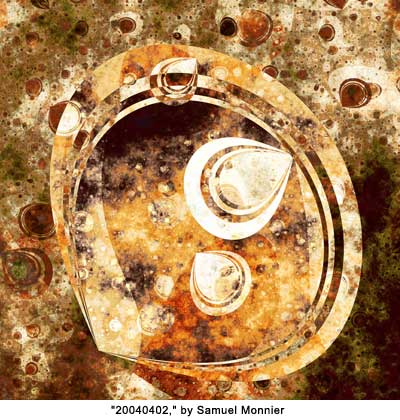
The title of this picture does not involve any mathematical riddle, but is simply the reference number by which Samuel Monnier identifies his pictures. This young Swiss man, who is preparing for his PhD in theoretical physics, does not like to put titles on his pictures as he feels it interferes with the sensations his work can produce in the viewer. The basic concept on which this image rests is to begin with a more or less repetitive initial design and superimpose various layers with this design at different scales. This procedure generates an image that shows structures with a wide range of scales, although from a strict point of view one cannot consider it to be fractal.
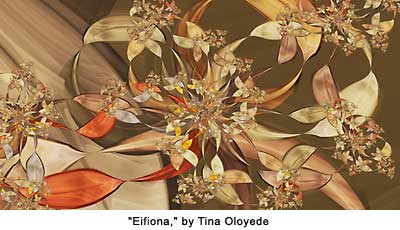
Tina Oloyede left her profession as a medical doctor to become a self-taught fractal artist, a passion and obsession since 1999. Residing in England, she balances her artistic activity with the care of her young family. She is actually one of the most versatile and publicly-appreciated fractal artists. For this picture she used 13 different formulas: 7 for building the basic structure of the image, 3 for adding different textures, and another 3 for controlling the coloring of the image. The name of the picture, "Eifiona," is the Welsh name of a friend of the artist, who ordered the image with one condition, that it be of "The Autumn" and in return granted absolute freedom to make the design and finish of the image. Tina Oloyede's capacity for artistic expression is unquestionable; it is impossible to see this picture without an autumnal image appearing in our mind.
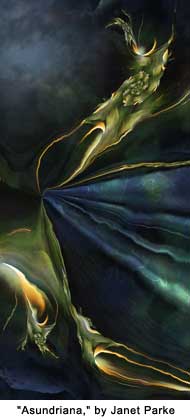
Janet Parke, born in Memphis (USA), has passed the major part of her life as a ballet dancer, choreographer, and dance professor. In 1999 she began to exhibit and sell her fractal art, characterized by an extraordinary sensitivity and coloring style unknown until then. Janet Parke replaces the characteristic loud and bright colors of the first generations of fractal art with smooth, rich tones and delicate shades. Her style will be imitated by a new generation of fractal artists. "Asundriana" is based on a variant of the Julia set ( $z\rightarrow z^2 + c$ ) such that the parameters $c$ and $z$ are manipulated to produce distortions in the typical spiral structures of this set. The name of the image comes from the word asunder, since the structure of the image seems to fold into and separate from itself.

Joseph Presley has worked with traditional art forms since he was a child, but discovered his favorite form of expression in fractal art, which produces the sensation of painting with the same tools that make nature beautiful. This image was generated by means of a variant of the Barnsley formula, "IFS-Barnsley-JockIII," written by Jock Cooper, and colored basically with the algorithm "fBm Popcorn Traps," written by Mark Townsend. The name of the picture, Tribute to Zemela, refers to an artist friend of the author, Lisa Thallauer, for whom Joseph Presley designed the image, being inspired by an imaginary wooden object.
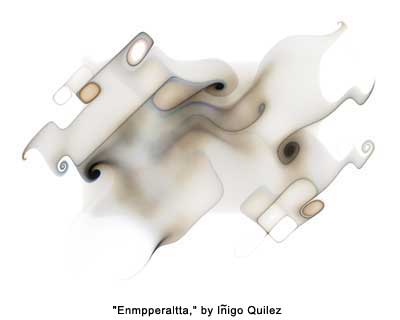
Inigo Quilez is an engineer born in the Basque Country, Spain, who actually works in Belgium designing virtual reality tools. The word that titles the picture, Enmpperaltta, signifies nothing; it is simple a permutation of the French word "L'Appartement." The reason is the obsession shown by the author while trying to buy the perfect apartment in Brussels; that goal was finally achieved and he celebrated with this image. Enmpperaltta is in fact a still frame from an animation calculated by means of proprietary software written in the C language from a variant of the well-known Pickover algorithm, a formula that generates shapes resembling those produced by mixing fluids, for example liquids of different colors. To generate the image, the formula was repeated three times with slightly altered parameters, each in a separate process, and applied to the three basic components of color in the image: red, green and blue, that are combined together to produce the final result.

"Sanctuary" consists of 19 layers, each one of which contains variations of the orbit trap algorithm. The traps are geometric shapes placed in the complex plane that end iteration of a point when its orbit falls within the shape, hence the name. The shape, size, and location of the traps permit Nicholas Rougeux to control the appearance of each of the layers, which are then combined together as if they were transparencies held up to light. Nicholas Rougeux, a North American web developer, reinforces in this picture the idea of a sanctuary by including smooth curves on the sides that simultaneously create sensations of protection and welcome. The mild colors also help to obtain the objective of evoking a comfortable place where spirits are free.
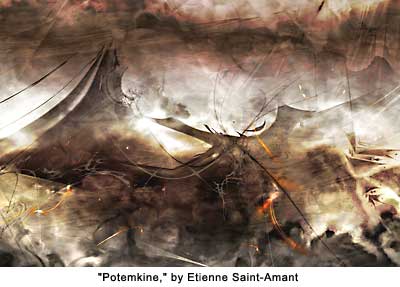
Etienne Saint-Amant is a Canadian scientist passionate for art and mathematics. He has had various exhibitions both individual and collective, he has presented conferences on art and mathematics and he has appeared in numerous programs on radio and television. His work can be seen on CD and book covers, calendars and web pages. "Potemkine" is a pseudo-abstract composition that portrays the intense emotion lived during the rebellion of the battleship Potemkin in the port of Odessa, Ukraine, in 1905. It brings to mind the ship enveloped in smoke, the flying projectiles, the din of the battle: a scene of the terrible emotional conflict of the Russian troops brought about by the orders to quash the rebellion and those sentiments confronted by compassion towards their compatriots. The image was created to commemorate, a century later, these events.
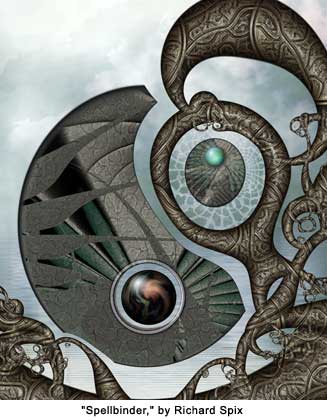
This image was formed with no less than 105 fractal layers composed of a large number of different coloring algorithms applied to a Phoenix set. It is the kind of image in which the composition enjoys much importance and in which many of the formulas are used to correct or emphasize small details, at times almost imperceptibly. The name of the image comes from the idea of representing an ancient artifact, enigmatic, bound to legend and secret mysteries. The author of this complex picture, Richard Spix, has created fractal art since 1996 in Florida (USA) where he works as a technical engineer.

Mark Townsend is a complete fractal artist who combines a refined technique with a marvelous creativity. This versatile Australian programmer has designed dozens of formulas for the program Ultra Fractal, but also gets part of his fame as the author of the popular software Apophysis. Mark Townsend is one of the authors who has contributed much to the recognition of fractal art, providing a work that is both innovative and at the same time personal. For this image, he tried to create shapes that did not appear to be made with a computer. The lines were included to emphasize the two-dimensional nature of the image.
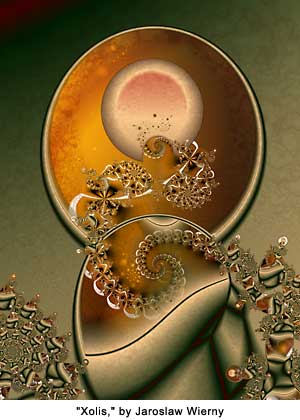
"Xolis" is an abstract word for an abstract picture. Each person can give to it the significance they want, as the author does not pretend to predispose the viewer. The image was generated with Ultra Fractal and consists of 10 layers containing the two most famous fractal sets, the Julia set and the Mandelbrot set. Six different coloring algorithms are applied to these. Jaroslaw Wierny is a Polish graphic designer profoundly interested in the Buddhist philosophy, which he relates to the fractal structure of the world.
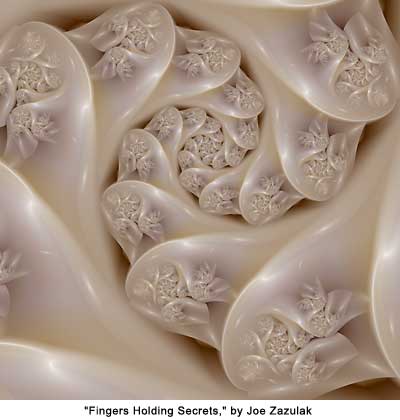
Joe Zazulak retired at the age of 55 from the United States Department of Veterans Affairs in order to dedicate himself from then on to fractal art, to which he is a certified addict. This picture is called "Fingers Holding Secrets," and the name came to his mind while the image appeared slowly on his computer. From then he only worked in providing the delicate and smooth pearlescent texture that characterizes the image. Joe Zazulak never plans his images in advance, nor intuits what they will be after the creative process. He begins his works with a very simple structure, with hardly any color, and adds variations to the shape parameters intuitively until he obtains a pleasing result.



